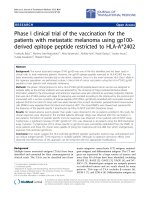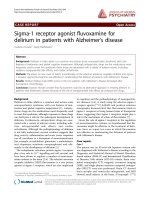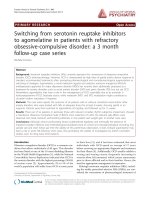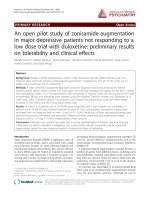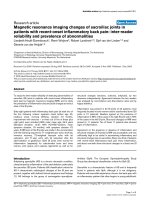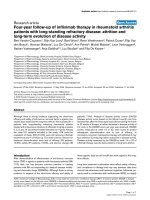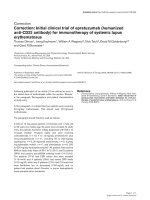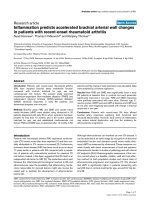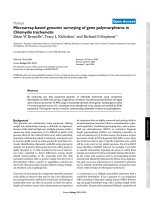Báo cáo y học: " Phase IIb randomized trial of adjunct immunotherapy in patients with first-diagnosed tuberculosis, relapsed and multi-drug-resistant (MDR) TB" doc
Bạn đang xem bản rút gọn của tài liệu. Xem và tải ngay bản đầy đủ của tài liệu tại đây (261.84 KB, 9 trang )
ORIGINAL RESEARCH Open Access
Phase IIb randomized trial of adjunct
immunotherapy in patients with first-diagnosed
tuberculosis, relapsed and multi-drug-resistant
(MDR) TB
Dmitry A Butov
1
, Yuri N Pashkov
1
, Anna L Stepanenko
1
, Aleksandra I Choporova
1
, Tanya S Butova
1
,
Dendev Batdelger
2
, Vichai Jirathitikal
3
, Aldar S Bourinbaiar
4
, Svetlana I Zaitzeva
1*
Abstract
Placebo-controlled, randomized, phase 2b trial was conducted in 34 adults comprising 18 first-diagnosed (52.9%), 6
relapsed (17.6%), and 10 MDR-TB (29.4%) cases to investigate the safety and efficacy of an oral immune adjunct
(V5). The immunotherapy (N = 24) and placebo (N = 10) arms received once-daily tablet of V5 or placebo for one
month in addition to conventional anti-TB therapy (ATT) administered under directly observed therapy (DOT).
The enlarged liver, total bilirubin, erythrocyte sedimentation rate, lymphocyte and leukocyte counts improved
significantly in V5 recipients (P = 0.002; 0.03; 8.3E-007; 2.8E-005; and 0.002) but remained statistically unchanged in
the placebo group (P = 0.68; 0.96; 0.61; 0.91; and 0.43 respectively). The changes in hemoglobin and ALT levels in
both treatment arms were not significant. The body weight increased in all V5-treated patients by an average 3.5 ±
1.8 kg (P = 2.3E-009), while 6 out of 10 patients on placebo gained mean 0.9 ± 0.9 kg (P = 0.01). Mycobacterial
clearance in sputum smears was observed in 78.3% and 0% of patients on V5 and placebo (P = 0.009). The
conversion rate in V5-receiving subjects with MDR-TB (87.5%) seemed to be higher than in first-diagnosed TB
(61.5%) but the difference was not significant (P = 0.62). Scoring of sputum bacillary load (range 3-0) at baseline
and post-treatment revealed score reduction in 23 out of 24 (95.8%) V5 recipients (from mean/median 2.2/3 to 0.3/
0; P = 6E-010) but only in 1 out of 10 (10%) patients on placebo (1.9/ 1.5 vs. 1.8/1; P = 0.34). No adverse effects or
TB reactivation were seen at any time during follow-up. V5 is safe as an immune adjunct to chemotherapeutic
management of TB and can shorten substantially the duration of treatment.
Introduction
Tuberculosis (TB) is a re-emerging global public health
problem, especially in developing countries. Ukraine is a
representative country as it concerns the TB epidemic.
In 1961, the incidence of TB in Ukraine was 155 cases
per 100,000 individuals, which then declined to 32 cases
per 100,000 in 1991. However this trend reversed and
by 2008 the incidence became 81 per 100,000. The mor-
tality doubled from 10.2/100,000 to 21.6/100,000
between 1990 and 2001 [1]. In addition the Ukraine
experiences the worsening epidemic of drug resistant
TB. Isoniazid and rifampicin resistance, which defines
the MDR-TB, has been found in 44% and 32.9% of TB
isolates [2]. The success rates of TB therapy in Ukraine
are below average when compared with other regions of
the world [3]. Despite availability of TB drugs the situa-
tion is far from ideal and it is clear that better therapeu-
tic interventions are needed to reverse the current trend.
Oral therapeutic vaccine V5 was originally developed
for the management of chronic hepatitis B and C [4-6].
The preparation is derived from pooled blood of HBV-
and HCV-positive donors, which following chemical-
and heat inactivation was formulated into an oral pill
according to proprietary technology developed by us [6].
It is well known that one third of people carry M. tuber-
culosis without showing symptoms of the disease.
* Correspondence:
1
Department of Phtysiatry and Pulmonology, Kharkov National Medical
University; Kharkov, Ukraine
Full list of author information is available at the end of the article
Butov et al. Journal of Immune Based Therapies and Vaccines 2011, 9:3
/>© 2011 Butov et al; licensee BioMed Central Ltd. This is an Open Access article distributed under the terms of the Creative Commons
Attribution License ( which permits unrestricted use, distribution, and reproduction in
any medium, provid ed the original work is properly cited.
Therefore V5 inherently contains circulating M. tuber-
culosis antigens. Duri ng hepatitis C trial in 20 patients
who happened to have pulmonary TB with HIV-co-
infection, V5 produced mycobacterial clearance in spu-
tum smears of 94.4% of patients within one month [7].
Subsequent, one-month, placebo-controlled trial in 55
patients confirmed the anti- TB property of V5 reveal ing
negative smear conversion in 96.3% of treated subjects
[8]. Our study was, thus, aimed to verify these findings
in an independent clinical setting at our TB hospital in
Kharkov. The advantage of adding V5 to standard ATT
was compared to a treatment regimen consisting of
ATT and placebo.
Materials and methods
Patients
The study involved 18 first-diagnose d TB (1
st
Dx; 52.9%),
6 relapsed TB (RTB; 17.6%), and 10 patients with con-
firmed multi-drug resistant TB (MDR; 29. 4%). The
patient population comprised 7 females and 27 males
between ages 20-60 years. The V5 arm had 24 indivi-
duals with mean ± SD (median) age 40.8 ± 12 (41)
years. The mean/median duration of A TT prior to V5
administration was 1.6 ± 2.5/1 mo nths. The 10 TB
patients on placebo had mean ± SD (median) age 34.8 ±
3.58 (35.5) years. The mean/median duration of che-
motherapy prior to addition of placebo was 0.5 ± 0.7/0
months. All study patients presented with moderate to
severe form of pulmonary TB. Most common symptoms
were prolonged heavy cough, pain in the chest, high
fever, profuse night sweats, fatigue, dyspnea, hemoptysis,
and loss of weight and appetite. Active pulmonary
tuberculosis was certified by a medical history and clini-
cal findings compatible with tuberculosis, a chest X-ray
showing lung involvement, and positive sputum smear
for acid-fast bacilli (AFB) and the culture of M. tubercu-
losis. None of patients in the present study had HIV or
viral hepatitis. Conduct of the trial has been approved
by the internal review board and has ClinicalTrials.gov
Identifier: NCT01222338.
Randomization, clinical endpoints and exclusion/inclusion
criteria
Any pat ient who prese nted with pul monary TB was
enrolled into this study and randomly allocated into
two arms according to computer-generated random
numbers table, i.e., simple randomization procedure.
Original plan was to evaluate 35 patients, because we
had this specific number of patients available at our
hospital wards at the time when study was ready to go.
Therefore, we have generated random 35 numbers and
have assigned apriori, even numbers to V5 and odd
numbers to placebo. The random sequence of digits
we have obtained had by chance higher proportion of
even than odd numbers: i.e., 24 vs 11. In placebo
group we ended up with 10 instead of 11 patients
because one patient assigned to this group had
declined to participate. The primary endpoint of inter-
est in this study was the effect of the therapy on myco-
bacterial clearance in sputum smear. Secondary
endpoints were changes in biochemical and hematol-
ogy parameters. The difference in baseline lab and bio-
chemistry characteristics between groups was totally
random and their time on TB drugs prior to V5 was
also a random event. Additional secondary endpoints
of interest were effects on body weight and liver size.
Treatment regimens
All patients received either standard TB therapy consist-
ing of orally administered Izo niazid (H; 300 mg); Rif am-
picin (R; 600 mg); Pyrazinamide (Z; 2,000 mg);
Ethambutol (E; 1200 mg); and intramuscular injection of
Streptomycin (S; 1,000 mg) or individualized treatment
regimen as deci ded by our medi cal st aff based on results
of drug resistance testing or prior medical history (Tables
1 and 2). The anti-TB drugs were procured through the
centralized national supply system of Ukraine. Patients in
V5 and placebo arms received in addition t o ATT once-
daily tablet of V5 or placebo; usually 30 minutes before
or after breakfast . The treatment was administered to
hospitalized patients for 30 days under directly observed
therapy (DOT). V5 is approved in 2008 by th e Ministry
of Health of Ukraine as an immunomodulating supple-
ment for the management of chronic hepatitis. As we
had not known prior to the accidental discovery that V5
may benefit TB patients we have not much information
regarding the exact con tent of M. tube rculosis antig ens
[7]. A new formulation (V7) specifically designed for TB
is now being tested in preclinical studies and which will
be specifically characterized in regard to its mycobacterial
antigenic content.
Laboratory evaluation
The quantitative sputum bacillary load as measured by
acid-fast bacilli (AFB) smears was conducted at baseline
and at 30 days post-treatment. S mears were scored in a
blind fashion from 3 to 0 according to the severity of
bacterial load. TB drug resistance was determined by
readily available commerci al kit (Tulip Diagnostics, Goa,
India). The a ctivity of alanine transaminase (ALT) was
measur ed according to the procedure described by Reit-
man and Frankel [9 ]. Other biochemistry and hematol-
ogy parameters were evaluated by standard routine
techniques at baseline and at one month post-treatment.
Statistical analysis
The obtained results were analyzed with statistical soft-
ware STATMOST (Datamo st, South Sandy, UT).
Butov et al. Journal of Immune Based Therapies and Vaccines 2011, 9:3
/>Page 2 of 9
Table 1 Baseline and outcome characteristics of TB patients receiving V5 in combination with TB drugs for 30 days
No. Sex Age Months
on ATT
prior
to V5
Dx TB
drugs
regime
Smear
status
Liver size
in cm over
normal
Erythrocyte
sedimentation
rate (mm/h)
Lymphocytes
(%)
Leukocytes
(× 10
9
/L)
Hemoglobin
(g/L)
Body weight
(kg)
Total
bilirubin
(μmol/L)
ALT
(mM/h/ml)
before after before after before after before after before after before after before after before after before after
1M 43 0 1
st
Dx HRZE 3 1 2 0 50 30 18 23 11.7 9.2 129 122 64 65 8.8 8.8 0.4 0.1
2M 39 0 1
st
Dx HRZE 3 1 0 1 17 16 28 25 4.4 5.4 142 139 65 66 9.9 8.8 0.2 0.6
3M 44 1 1
st
Dx HRZES 1 0 1 0 21 15 19 29 6.1 5.6 127 116 74 78 8.8 9.9 0.6 0.5
4M 60 3 1
st
Dx HRZES 3 0 1 0 27 20 29 31 6.1 6 144 122 71 74 8.8 8.8 0.7 0.1
5F 27 1 1
st
Dx HRZES 3 2 1 0 58 40 16 22 11 8 101 110 43 49 8.8 8.8 0.7 0.7
6M 26 3 1
st
Dx HRZES 3 1 3 1 15 6 30 37 11.6 6 158 140 66 69 8.8 12.1 0.9 1.7
7M 57 1 1
st
Dx HRZES 2 0 0 0 32 9 21 34 5.3 5.1 109 123 60 63 12.1 9.9 0.1 0.5
8M 31 0 1
st
Dx HRZES 1 0 0 0 36 26 21 29 7.5 6.6 134 136 62 68 8.8 9.9 0.3 0.4
9M 39 0 1
st
Dx HRZES 2 1 0 0 50 30 14 17 11.7 9.6 154 144 63 67 8.8 8.8 0.2 0.2
10 M 31 3 1
st
Dx HRZES 3 0 0 0 37 2 33 46 9.7 4 145 151 64 67 9.9 8.8 0.4 0.4
11 M 59 0 1
st
Dx HRZES 1 0 1 1 25 24 27 29 6.6 5.2 138 136 61 66 18.1 12.1 0.3 0.5
12 M 26 0 1
st
Dx HRZES 3 0 3 1 19 9 24 21 5.7 6.0 156 153 70 73 8.8 8.8 1.3 0.7
13 M 51 1 1
st
Dx HRZES 3 0 1 2 15 6 16 29 14.2 6.9 142 150 81 81 12.1 8.8 0.6 0.9
14 F 46 1 RTB HRZES 3 0 0 0 17 3 17 21 8.3 7.7 103 110 52 58 8.8 8.8 0.3 0.1
15 F 54 0 RTB RZEO 3 0 3 1 16 8 24 34 6.1 5.1 143 128 58 59 8.8 8.8 1.2 0.6
16 F 35 1 RTB HRZEA 3 0 0 0 32 15 18 37 6.7 5.5 142 136 62 67 8.8 8.8 0.2 0.2
17 M 49 1 MDR HRZEO 3 0 1 1 55 40 18 37 20.4 7.5 138 100 73 75 12.1 9.9 0.8 0.8
18 M 29 9 MDR HEAOC 3 1 5 3 25 14 11 26 7.9 7.9 129 138 59 62 8.8 8.8 0.5 0.9
19 F 53 2 MDR ZEPAO 0 0 0 0 19 17 35 31 4.4 5.8 139 167 55 59 14.3 10.4 0.3 0.4
20 M 29 0 MDR ZEPAO 2 0 1 0 10 8 33 35 10 6.2 147 148 65 69 8.8 8.8 0.6 0.6
21 M 29 4 MDR ZEPAO 2 0 3 0 25 17 26 37 10.1 6.8 135 133 57 60 9.9 8.8 1.3 0.6
22 M 49 1 MDR ZEPO 1 0 2 0 24 17 12 26 5.3 4.9 159 137 72 74 14.2 9.9 1 0.6
23 M 52 0 MDR ZPAO 1 0 3 1 24 18 24 26 5 4.2 124 128 68 73 13.5 8.8 1.4 0.7
24 M 22 1 MDR CsCiGF 1 0 0 0 23 18 25 27 19.6 7.2 121 131 66 73 8.8 8.8 0.1 0.2
5/19 Mean
= 40.8
±12
Median
=41
Mean =
1.6
± 2.5
Median
=1
1
st
Dx =
13
RTB = 3
MDR = 8
1/23
2.2/3
18/6
0.3/0
1.3
± 1.4/
1
0.5
± 0.8/
0
28 ±
13.4
17 ±
10.4
22.5
± 6.8
29.5
± 6.7
9±
4.3
6.4 ±
1.4
135.8
± 15.8
133.3
±
15.5
63.8
± 7.9
67.3
±
7.3
10.4
± 2.5
9.4
±
0.99
0.6
± 0.4
0.54
±
0.35
P = 0.000027 P = 0.0018 P = 8.3E-007 P = 2.8E-005 P = 0.0024 P = 0.39 P = 2.3E-009 P = 0.03 P = 0.47
TB drugs used in this arm are abbreviated as follows: Isoniazid (H), Rifampicin (R), Pyrazinamide (Z), Ethambutol (E), Streptomycin (S), Ofloxacin (O), Amikacin (A), Capreomycin (C), Para-aminosalicylic acid (P), Cs
(Cycloserine), Cilastatin (Ci), Gatifloxacin (G), Metronidazole (F), Prothionamide (Pt).
Butov et al. Journal of Immune Based Therapies and Vaccines 2011, 9:3
/>Page 3 of 9
Table 2 Baseline and outcome characteristics of TB patients receiving placebo in combination with TB drugs for 30 days
No. Sex Age Months on
ATT
prior to
placebo
Dx TB
drugs
regime
Smear
status
Liver size
in cm over
normal
Erythrocyte
sedimentation
rate (mm/h)
Lymphocytes
(%)
Leukocytes
(× 10
9
/L)
Hemoglobin
(g/L)
Body weight
(kg)
Total
bilirubin
(μmol/L)
ALT
(mM/h/ml)
before after before after before after before after before after before after before after before after before after
1M22 1 1
st
Dx HRZSE 1 1 1 0 3 6 22 36 6.1 8.7 155 150 74 75 12.1 9.9 0.3 0.3
2F35 0 1
st
Dx HRZSE 3 3 1 0 22 41 8 10 8 14.1 75 80 45 45 8.8 8.8 0.4 0.6
3M40 0 1
st
Dx HRZSE 1 1 0 1 35 32 12 11 11.8 11.1 158 150 62 62 9.9 9.9 0.4 0.6
4F30 0 1
st
Dx HRZSE 1 1 0 1 8 10 21 16 7.2 7.4 126 120 69 69 8.8 14 0.2 0.6
5M20 0 1
st
Dx HRZSE 3 3 0 0 50 35 27 26 9.2 10.9 116 110 64 66 8.8 8.8 0.3 0.2
6 M 53 2 RTB HRZSE 2 1 2 1 23 27 19 23 5.5 4.6 86 89 84 86 12.1 8.8 0.3 0.1
7 M 42 0 RTB HRZSE 3 3 1 1 52 49 19 17 10 9.8 113 115 60 61 8.8 8.8 0.1 0.4
8 M 48 0 RTB HRZSE 3 3 0 0 47 38 40 37 11 10.3 139 129 60 61 8.8 17.2 0.1 0.4
9 M 22 1 MDR HRZSE 1 1 1 1 31 20 17 13 8.8 7.7 136 146 70 72 8.8 8.8 0.4 0.6
10 M 36 1 MDR ZAPPtO 1 1 3 3 33 30 27 25 10.1 9.1 107 131 69 69 21 12.1 0.7 1.7
2/8 Mean
= 34.8
± 3.58
Median
= 35.5
Mean
= 0.5
± 0.7
Median
=0
1.9 1.8 0.9
± 0.31
0.8
±
0.29
30.4
± 5.30
28.8
± 4.27
21.2 ±
8.9
21.4
± 9.7
8.77 ±
0.65
9.37
±
0.80
121.1
± 8.64
122
±
7.69
65.7
± 3.25
66.6
±
3.39
10.79
± 1.21
10.71
±
0.90
0.32
± 0.05
0.55
±
0.14
P = 0.34 P = 0.68 P = 0.61 P = 0.91 P = 0.43 P = 0.79 P = 0.01 P = 0.96 P = 0.055
TB drugs used in this arm are abbreviated as follows: Izoniazid (H), Rifampicin (R), Pyrazinamide (Z), Ethambutol (E), Streptomycin (S), Amikacin (A), Para-aminosalicylic acid (P), Prothionamide (Pt), Ofloxacin (O).
Butov et al. Journal of Immune Based Therapies and Vaccines 2011, 9:3
/>Page 4 of 9
The baseline quantitative values relative to the end of
study values were evaluated by paired or unpaired
Student t-test. Other statistical calculations such as
determination of standard deviation, mean and median,
were performed with the same software. The non-para-
metric or categorical values of treatment outcomes were
compared by Fisher’s exact two-tailed test. All statistical
analyses were done on intent-to-treat basis, invo lving the
total number of patients without subgrouping them into
responders and non-responders. The resulting probability
values were considered as significant at P ≤ 0.05.
Results
Lack of adverse reactions
During the entire duration of follow-up no adverse reac-
tions or reactivation of TB attributable to V5 were iden-
tified. Quite contrary patients who were receiving
chemotherapy along with V5 fared much better than
placebo recipients. While these findings can be consid-
ered as subjective, the quantitative endpoints det ailed
below indicate that the addition of V5 to ATT results in
better clinical outcome. The favorable response rates as
expressed in percentage values are shown in Figure 1.
Effect on hematology parameters
The effect of ATT and V5 on select white blood cells and
hematology parameters are shown in Tables 1 and 2.
Patients in V5 arm displayed positive changes that
appeared to be specific to V5 intervention as opposed to
the effect of ATT in placebo arm. In particular, the per-
centage of lymphocy tes increased among V5 treated
patients (from 22.5 ± 6.8 to 29.5 ± 6.7; P = 2.8E-005)
while patients in the control group failed to display any
significant changes (21.2 ± 8.9 vs 21.4 ± 9.7; P = 0.91).
Elevated leukocyte counts that are traditionally associated
with inflammation were reduced in V5-treated patients
(9 ± 4.3 vs 6.4 ± 1.4 × 10
9
/L; P = 0.0024) but not in the
placebo group (8.77 ± 0.65 vs 9.37 ± 0.80 × 10
9
/L; P =
0.43). Another marker of inflammation, the erythrocyte
sedimentation rate (ESR), declined significantly in V5
group (28 ± 13.4 vs 17 ± 10.4 mm/h; P = 8.3E-007) but
unchanged in placebo recipients (30.4 ± 5.30 vs 28.8 ±
4.27; P = 0.61). The content of hemoglobin remained at
the same level in V5 and place bo patients (135.8 ± 15.8
vs 133.3 ± 15.5 g/L; P = 0.39) (121.1 ± 8.64 vs 122 ± 7.69
g/L; P = 0.79) respectively. In general, V5 appeared to
have better effect in normalizing abnormal hematology
picture than placebo and ATT (Figure 1).
Effect on liver size and function
Liver size and serum biochemistry markers of liver func-
tion such as ALT and total bilirubin appeared to
improve among V5 recipients while patients in placebo
group tended to show signs of liver dysfunction (Figure 1).
Mean/median liver size in V5 arm reduced from 1.3 ± 1.4/
1 to 0.5 ± 0.8/0 cm above normal size (P = 0.002). No
changes were seen in placebo recipients (0.9 ± 0.3/1 vs 0.8
± 0.3/1 cm P = 0.68). While changes in ALT were not sta-
tistically significant, the opposite trend in the outco me
was observed. ALT levels in V5 patients appeared to
decrease from 0.6 ± 0.4 to 0.54 ± 0.35 mM/h/ml (P =
0.47) while in placebo recipients they had almost doubled
from baseline values 0.32 ± 0.05 vs 0.55 ± 0.14 mM/h/ml
(P = 0.055). Total bilirubin decreased in V5 arm from 10.4
± 2.5 to 9.4 ± 0.99 μmol/L (P = 0.03) but in placebo no
significant decrease was observed 10.8 ± 1.2 vs 10.7 ± 0.9
μmol/L (P = 0.96).
Effect on body weight
Prior to study initiation patient s in both groups had
identical underweight problem. The mean baseline
weight in V5 and placebo groups was 63.8 ± 8 kg and
0
20
40
60
80
100
120
ESR
Lymphocyte %
Leukocyte count
Hemoglobin
ALT
Bilirubin
Liver size
Weight gain
Sputum conversion
Response rate in %
V
5
Pl
acebo
Figure 1 The proportion of ATT-treated patients in V5 and placebo arms who have benefited from the therapy according to the
measured endpoints.
Butov et al. Journal of Immune Based Therapies and Vaccines 2011, 9:3
/>Page 5 of 9
65.7 ± 10.3 kg respectively (P = 0.6 by unpaired t-test).
The average body weight accrual in V5 group was 3.5 ±
1.8 kg (P = 2.3E-009). Only one patient failed to gain
weight, in remaining 23 patient s (95.8%) the increase in
body mass ranged between 1-7 kg. In placebo arm 60%
of patients gained on average 0.9 ± 0.9 kg (P = 0.01),
range 1-2 kg.
Effect on mycobacterial clearance
Bact erial clearance was scored in a blinded fashion after
AFB staining of sputum smears. One month later 78.3%
of V5 patients who had positive sputum smear at base-
line had negative findings, while none of patients cleared
bacteria in the placebo group - a difference that was sta-
tistically significant (P = 0.009 by Fisher’ sexacttwo-
tailed test) (Figure 2). In placebo group only one patient
out of 10 had shown decrease in AFB score (10%)
whereas among 24 patients in V5 group everyone
(except patient #19) had decreased AFB score (95.8%).
Paired t-test of quantitative scoring of sputum bacillary
load at baseline and post-treatment revealed that the
decrease in V5 group was highly significant (from
mean/median 2.2 ± 0.98/3 to 0.29 ± 0.55/0; P = 6E-010)
but no difference was seen in placebo recipients (1.9 ±
0.99/1.5 to 1.8 ± 1.03/1; P = 0.34). No differences were
seen in conversion rate between 13 first-diagnosed,
drug-sensitive TB and 8 multi-drug resistant TB cases
in V5 arm (P = 0.62 by Fisher’ s 2×2 exact test); both
forms of TB responded equally well to the immunother-
apy (Figure 2).
Discussion
This placebo-controlled, comparative study involv ing 34
patients with first-diagnosed TB, relapsed TB, and
MDR-TB reveals that when conventional or individua-
lized TB drug regimens are combined with V5, the com-
bination can produce significant improvement in clinical
endpoints and clearance of M. tuberculosis at higher
rate than in patients on placebo . Biochemistry and
hematological analysis of blood samples support favor-
able adjunctive effect of V5, which has not shown any
adverse effects throughout the study duration.
Our findings support two earlier clinical trials of V5
demonstrating favorable outcome in TB patients [7,8].
These studies reported a range of beneficial effects
including better quality of life, body weight gain, reversal
of ATT-associated hepatotoxicity, reduced inflammation,
faster deffervescence, and higher clearance rate of M.
tuberculosis in sputum smears. Furthermore, the adjunct
immunotherap y resulted in much shorter duration of
treatment than among those who received standard
ATT. Both prior studies were conducted at the Lisi-
chansk Regional TB Dispensary but these results are
now confirmed by the present study performed indepen-
dently at our TB hospital based in Kharkov.
The normalization of infl ammatory indices is consid-
ered to have favorable effect on the course of the TB
disease [10,11]. There were earlier indications that V5
exhibits the anti-inflammatory activity [4-8]. These
observations are supported by this study. Contrary to
the outcome in placebo group the markers of inflamma-
tion such as elevated leukocyte counts and prolonged
erythrocyte sedimentation rate have been significantly
reduced in V5 recipients. A favorable change in the
blood picture is supported by the increase in total lym-
phocyte percentage among V5 recipients, but not in the
control group. The restoration of suppressed lympho-
cyte counts and decrease in leukocyte counts is asso-
ciated with positive treatment outcome [12]. Thus,
changes in relative and absolute lymphocyte a nd leuko-
cyte numbers may hold promise as surrogate markers of
treatment response. Further studies aimed at evaluating
specific immune phenotypes of peripheral blood cell
subsets, including their functional characterization are
needed.
The hepatotoxicity induced by anti-TB drugs has ser-
ious adverse consequences to treated patients and
imposes limitations on treatment options [13]. Addition
of V5 appeared to reduce baseline bilirubin and ALT
levels, as well as the abnormal liver size when compared
to placebo regimen. These observations confirm prior
studies in which V5 has been shown to counter the
hepatotoxicity of TB drugs [8,9]. For this reason the use
of V5 in combination with ATT is advisable to prevent
or reverse iatrogenic liver damage.
The immunotherapy has shown clear benefit in rever-
sing body weight loss. The average gain in V5 and pla-
cebo groups was 3.5 kg and 0 .9 kg which is almost
87.5
100
61.5
78.3
MDR
RTB
1st DX
Total
V5 Placebo
Figure 2 The percentage of sputum smear-negative patients in
placebo and V5 arms administered in combination with TB
drugs for one month. The upper paired bar shows conversion rate
in placebo recipients (0%) in comparison to V5 recipients (78.3%) in
a total number of enrolled patients (N = 34). Lower paired bars
show conversion rates among first-diagnosed TB (1stDx); relapsed
TB (RTB); and multidrug-resistant TB (MDR) respectively.
Butov et al. Journal of Immune Based Therapies and Vaccines 2011, 9:3
/>Page 6 of 9
identical to the results of placebo controlled trial invol-
ving a comparable group of 55 TB patients from the
Lisichansk TB dispensary, i.e., 3.4 kg (59.7 ± 8 vs 63.1 ±
9 kg; P = 5.7E-007) and 1.07 kg (59.1 ± 10 vs 60.1 ±
10.4 kg; P = 0.003) respectively [8]. In contrast, the
mean weight gain observed in the earlier conducted,
open-label trial involving 20 patients with HIV-TB was
7.7 kg (P = 4.6E-007) [7]. This almost two-fold discre-
pancy is perhaps due to the fact that all these patients
had HIV infection - a condition that is associated with
worsened wasting. Nevertheless, there appears to be the
strong relationship between body weight gain and favor-
able outcome, which needs to be confirmed in a larger
cohort of patients in independent clinical settings
[14,15].
Conversion of sputum smear from positive to negative
is a main indicator of the efficacy of anti-TB interven-
tion. We have observed that V5 accelerates and signifi-
cantly enhances bacillary clearance as compared to
control group on ATT (Figs. 1 and 2). This observation
supports earlier studies at Lisichansk TB dispensary
which reported similar results albeit at higher conver-
sion rate [7,8]. The difference in outcome between pla-
cebo and V5 recipients was also significant. In the prior
placebo- controlle d study the conversion in placebo arm
was seen in 25% of patients while in our hands 0% con-
verted. We do not know what the reason for such a dis-
crepancy is. In Arjanova et al., study the duration of
ATT prior to study initiation 4 ± 3/3 and 3.4 ± 2.7/3
months respectively [8]. In our study mean ± SD/med-
ian duration of ATT prior to V5 and placebo adminis-
trat ion was shorter and uneven 1.6 ± 2.5/1 versus 0.5 ±
0.7/0 months. This discrepancy was mainly due to the
presence of outlier patients in V5 group. Particularly,
five patients #4, #6, #10, #18, and #21 were on TB
drugs for 3, 3, 3, 9, and 4 months respectively (Table 1).
Nevertheless, while difference in time on TB drugs can
account to some degree for discrepancy in obtained
results, we do not think that this was the main reason.
This is supported b y stratified analysis of patients o n
V5. If we exclude outlier patients we have 19 individuals
who were on TB drugs for a n average 0.57 months,
which is same as in the placebo group (P = 0.76; by
unpaired t-test). In this subgroup of patients 15 out of
19 (78.9%) patients had converted after one month,
which is identical to the original conversion rate 78.3%
we have observed for V5 group as a whol e. Thus, while
longer pre-treatment with TB drugs may contribute to
higher conversion rate as shown by Lisichansk study,
in our case this contribution was negligible, since the
conversion rate was still drastically different between
V5 and placebo, r egardless how long they were treated
with TB drugs. Nevertheless, additional studies are
needed to assess the effect of the length of prior
exposure to ATT in relation to the conve rsion rate
induced by immunotherapy.
V5 contains heat-inactivated M. tuberculosis antigens
which are commonly present in the blood of people who
do not have active TB disease [16]. In this sense V5
resembles therapeutic vaccine RUTI which contains
detoxified M. tuberculosis antigens [17]. There are sev-
eral other immune adjuncts of bacterial origin which
enhancesputumconversionwhenusedtogetherwith
ATT. These include M. vaccae [18], M. p hlei [19], M. w
[20], and Likopid [21]. Even attenuated M. bovis prepara-
tion, known as BCG vaccine since 1921, has been occa-
sionally used as a t herapeutic modality. For example, in
Chinese army trial involving 360 patients with MDR-TB
the negative sputum conversion rate in BCG recipients
was 98.3% and 97.2% in chemotherapy control. While
this difference was not significant the recurrence of TB
aft er 5 years was 2.3% in the BCG group, but 6.9% in the
control group [22]. The authors of this study, however,
did not mention whether use of BCG was accompanied
by reactivation of TB or aggravation of disease symptoms -
a phenomenon first observed by Robert Koch - the
discoverer of Mycobacterium tuberculosis.
Koch’ s phenomenon of TB reactivation has been
thwarting the development of safe and effective thera-
peutic vaccine since 1890 [23]. While the risk of indu-
cing deleterious Koch-like reaction appears to be
relatively low in humans [24], extreme caution is still
needed as it occurs commonly in animal models of
post-exposure vaccination when various TB vaccine
candidates, including BCG, were tested and produced
occasionally lethal outcomes [25-30]. Recent BCG revac-
cination trial in the area of high TB endemicity with
increased probability of occult disease has produced
worrisome outcome, which might be interpreted as a
fatal Koch-like TB reactivation. The trial carried out in
Guinea-Bissau on 2871 children was stopped prema-
turely because of a cluster of deaths in the BCG arm of
the study [31]. In our case we have not seen any reacti-
vation of the disease; quite contrary we have consistently
observed the reduction of inflammation signs such as
ESR, leukocytosis and fever. This, we believe, is largely
due to the well-known fact that orally delivered antigens
induce immune tolerance instead of immune activation,
e.g., Koch’ s reaction [32]. An immunomodulator we
have studied extensively in the past is a multiherbal
extract Dzherelo (Immunoxel) which has shown similar
properties as V5 on the conversion rate in drug-sensitive
as well as MDR-TB and reduction of inflammation
[11,33]. Contrary to TB drugs the efficacy of immune-
based therapy on drug- resistant TB is considered to be
the same as against drug-sensitive strains [34]. In our
hands V5 seemed to be equally effective against both
forms of TB, as no statistical difference was observed
Butov et al. Journal of Immune Based Therapies and Vaccines 2011, 9:3
/>Page 7 of 9
when we compared the conversion outcome between
first-diagnosed TB and relapsed/MDR-TB subsets of
patients.
Conclusions
V5 is shown to be safe and capable of reversing ATT-
associated hepatotoxicity. In addition, V5 reduces the
inflammation as evidenced by several hematolo gical and
biochemical markers. Weight gain and sput um smear
conversion rate have been significantly enhanced as
compared to conventional ATT. As evidenced by
obtained improvements the combinatio n of V5 and
ATT can shorten substantially the duration of treat-
ment. Our preliminary findings need to be explored
further in a larger population of patients followed for
longer periods of time to establish the usefulness o f V5
as a therapeutic TB vaccine.
Considering that 2 billion people are latently infected
with M. tuberculosis, it is likely that two different types of
prophylac tic TB vaccines will be needed: one is so called
pre-exposure vaccine to prevent mycobacterial infection in
naïve individuals and second, post-exposure vaccine, to
prevent TB disea se in tubercle bacilli carriers without
exacerbating disease manifestations. Up to now, the major-
ity of vaccine candidates are in the first category and only
M. vaccae and RUTI are considered to be in the second
category [35]. Studying V5 as post-exposure vaccine can
contri bute to better understanding of th e immunopatho-
genesis of TB resulting in the design of effective vaccines
and accelerate evaluation of their efficacy. In addition, V5
studies can yield important insights into correlates of
immune protection, which are still poorly understood [36].
List of abbreviations
1
st
Dx: first-diagnosed; A: amikacin; AFB: acid-fast bacilli; ALT: alanine
transaminase; ATT: anti-tuberculosis therapy; BCG: Bacille Calmette-Guérin; C:
capreomycin; Ci: cilastatin; Cs: cycloserine; DOT: directly observed therapy;
Dx: diagnosis; ESR: erythrocyte sedimentation rate; F: metronidazole; G:
gatifloxacin; H: izoniazid; Hb: hemoglobin; HBV: hepatitis B virus; HCV:
hepatitis C virus; HIV: human immunod eficiency virus; MDR: multi-drug-
resistant; O: ofloxacin; P: para-aminosalicylic acid; Pt: prothionamide; R:
rifampicin; RTB: relapsed TB; S: streptomycin; SD: standard deviation; TB:
tuberculosis; V5: Immunitor V-5; Z: pyrazinamide.
Acknowledgements
We thank all volunteers who participated in this study. The wholehearted
support of clinicians, nurses and lab personnel who contributed their effort
made this study possible.
Author details
1
Department of Phtysiatry and Pulmonology, Kharkov National Medical
University; Kharkov, Ukraine.
2
National Research Center for Infectious Diseases
(NRCID), Ulaanbaatar, Mongolia.
3
Immunitor Thailand Co., LLC, Bangpakong
Industrial Park, Chachoengsao, Thailand.
4
Immunitor USA Inc., College Park,
MD 20740, USA.
Authors’ contributions
DAB and YNP carried out the planning and conduct of the study, data
collection and manuscript preparation. ALS, AIC and TSB took part in the
conduct of study, data collection and interpretation. DB and ASB
participated in editing of the manuscript and statistical analysis of data. VJ
provided samples of V5 and prepara tions of the placebo and provided
guidelines for conduct of the study. SIZ supervised medical personnel and
arranged the ethical approval of the study. All authors read and approved
the manuscript.
Competing interests
ASB and VJ are officers and owners of Immunitor company, which
manufactures V5. All other authors declare that they have no competing
financial interests.
Received: 20 October 2010 Accepted: 18 January 2011
Published: 18 January 2011
References
1. Feshchenko YuI, Melnyk VM, Novozhilova IO, Lyrnyk SV: The mortality of
patients with tuberculosis: structure, dynamics and peculiarities in
epidemic period. Ukr Pulmonol J 2009, 3:5-9.
2. Nikolayevskyy VV, Brown TJ, Bazhora YI, Asmolov AA, Balabanova YM,
Drobniewski FA: Molecular epidemiology and prevalence of mutations
conferring rifampicin and isoniazid resistance in Mycobacterium
tuberculosis strains from the southern Ukraine. Clin Microbiol Infect 2007,
13:129-138.
3. Atun R, Olynik I: Resistance to implementing policy change: the case of
Ukraine. Bulletin of World Health Organization 2008, 86:147-154.
4. Batdelger D, Dandii D, Jirathitikal V, Bourinbaiar AS: Open label trial of
therapeutic hepatitis B vaccine V-5 Immunitor (V5) delivered by oral
route. Lett Drug Design Discovery 2007, 4:540-544.
5. Batdelger D, Dandii D, Jirathitikal V, Bourinbaiar AS: Open label trial of
therapeutic immunization with oral V-5 Immunitor (V5) vaccine in
patients with chronic hepatitis C. Vaccine 2008, 26:2733-2737.
6. Batdelger D, Dandii D, Dahgwahdorj Ya, Erdenetsogt E, Oyunbileg J,
Tsend N, Bayarmagnai B, Jirathitikal V, Bourinbaiar AS: Clinical experience
with therapeutic vaccines designed for patients with hepatitis. Curr
Pharm Design 2009, 15:1159-1171.
7. Arjanova OV, Prihoda ND, Yurchenko LV, Sokolenko NI, Frolov VM,
Tarakanovskaya MG, Jirathitikal V, Bourinbaiar AS: Phase 2 trial of V-5
Immunitor (V5) in patients with chronic hepatitis C co-infected with HIV
and Mycobacterium tuberculosis. J Vaccin Vaccinat 2010, 1:103.
8. Arjanova OV, Prihoda ND, Yurchenko LV, Sokolenko NI, Frolov VM,
Tarakanovskaya MG, Batdelger D, Jirathitikal V, Bourinbaiar AS: Adjunct oral
immunotherapy in patients with re-treated, multidrug-resistant or HIV
co-infected TB. Immunotherapy .
9. Reitman S, Frankel S: A colorimetric method for the determination of
serum glutamic oxalacetic and glutamic pyruvic transaminases. Am J Clin
Pathol 1957, 28:56-63.
10. Ostrovskiĭ VK, Asanov BM, Iangolenko DV: Some blood indices and the
leukocytic index of intoxication in tuberculosis, pneumonias, abscesses,
and cancer of the lung. Probl Tuberk Bolezn Legk 2005, 3:43-46.
11. Zaitzeva SI, Matveeva SL, Gerasimova TG, Pashkov YN, Butov DA,
Pylypchuk VS, Frolov VM, Kutsyna GA: Treatment of cavitary and
infiltrating pulmonary tuberculosis with and without the
immunomodulator Dzherelo. Clin Microbiol Infect 2009, 15:1154-1162.
12. Veenstra H, Baumann R, Carroll NM, Lukey PT, Kidd M, Beyers N, Bolliger CT,
van Helden PD, Walzl G: Changes in leucocyte and lymphocyte subsets
during tuberculosis treatment; prominence of CD3dimCD56+ natural killer
T cells in fast treatment responders. Clin Exp Immunol 2006, 145:252-260.
13. Saukkonen JJ, Cohn DL, Jasmer RM, Schenker S, Jereb JA, Nolan CM,
Peloquin CA, Gordin FM, Nunes D, Strader DB, Bernardo J,
Venkataramanan R, Sterling TR, ATS (American Thoracic Society)
Hepatotoxicity of Antituberculosis Therapy Subcommittee: An official ATS
statement: hepatotoxicity of antituberculosis therapy. Am J Respir Crit
Care Med 2006, 174:935-952.
14. Vasantha M, Gopi PG, Subramani R: Weight gain in patients with
tuberculosis treated under directly observed treatment short-course
(DOTS). Indian J Tuberc 2009, 56:5-9.
15. Yew WW, Leung CC: Prognostic significance of early weight gain in
underweight patients with tuberculosis. Am J Respir Crit Care Med 2006,
174:236-237.
16. Majumdar A, Kamble PD, Harinath BC: Detection of circulating free and
immune-complexed antigen in pulmonary tuberculosis using cocktail of
Butov et al. Journal of Immune Based Therapies and Vaccines 2011, 9:3
/>Page 8 of 9
antibodies to Mycobacterium tuberculosis excretory secretory antigens
by peroxidase enzyme immunoassay. Indian J Tuberc 2010, 57:67-74.
17. Vilaplana C, Montané E, Pinto S, Barriocanal AM, Domenech G, Torres F,
Cardona PJ, Costa J: Double-blind, randomized, placebo-controlled Phase
I clinical trial of the therapeutical antituberculous vaccine RUTI. Vaccine
2010, 28:1106-1116.
18. Stanford J, Stanford C, Grange J: Immunotherapy with Mycobacterium
vaccae in the treatment of tuberculosis. Front Biosci 2004, 9:1701-1719.
19. Zhao G-R, Feng D-H: A systematic review of inactivated Mycobacterium
phlei injection for adjunctive treatment of drug resistant pulmonary
tuberculosis. Pharm J Chin PLA 2009, 25:361-364.
20. Nyasulu PS: Role of adjunctive Mycobacterium w immunotherapy for
tuberculosis. J Exp Clin Med 2010, 2:123-129.
21. Svistunova AS, Pinegin BV, Selitskaia RP, Arshinova SS, Klimova EG,
Andronova TM, Batyrov FA, Simonova AV: The use of immunomodulator
likopid in the combined treatment pulmonary tuberculosis. Probl Tuberk
2002, 3:21-25.
22. Lei JP, Xiong GL, Hu QF, Li Y, Zong PL, Tu SH, Tu RY: Immunotherapeutic
efficacy of BCG vaccine in pulmonary tuberculosis and its preventive
effect on multidrug-resistant tuberculosis. Zhonghua Yu Fang Yi Xue Za
Zhi 2008, 42:86-89.
23. Kaufmann SH: Is the development of a new tuberculosis vaccine
possible? Nat Med 2000, 6:955-960.
24. Kato S, Tokunaga O, Yoshiyama T: Analysis of Koch’s phenomenon by
BCG vaccination with the multi-puncture method in Japan. Kekkaku 2010,
85:782-785.
25. Repique CJ, Li A, Collins FM, Morris SL: DNA Immunization in a mouse
model of latent tuberculosis: effect of DNA vaccination on reactivation
of disease and on reinfection with a secondary challenge. Infect Immun
2002, 70:3318-3323.
26. Moreira AL, Tsenova L, Aman MH, Bekker L-G, Freeman S, Mangaliso B,
Schröder U, Jagirdar J, Rom WN, Tovey MG, Freedman VH, Kaplan G:
Mycobacterial antigens exacerbate disease manifestations in
Mycobacterium tuberculosis-infected mice. Infect Immun 2002,
70:2100-2107.
27. Basaraba RJ, Izzo AA, Brandt L, Orme IM: Decreased survival of guinea pigs
infected with Mycobacterium tuberculosis after multiple BCG
vaccinations. Vaccine 2006, 24:280-286.
28. Radaeva TV, Nikonenko BV, Kapina MA, Mishchenko VV, Apt AS:
Experimental approaches to designing vaccines against tuberculous
infection reactivation. Probl Tuberk Bolezn Legk 2006, 5:45-48.
29. Cruz A, Fraga AG, Fountain JJ, Rangel-Moreno J, Torrado E, Saraiva M,
Pereira DR, Randall TD, Pedrosa J, Cooper AM, Castro AG: Pathological role
of interleukin 17 in mice subjected to repeated BCG vaccination after
infection with Mycobacterium tuberculosis. J Exp Med 2010,
207:1609-1616.
30. Derrick SC, Perera LP, Dheenadhayalan V, Yang A, Kolibab K, Morris SL: The
safety of post-exposure vaccination of mice infected with
Mycobacterium tuberculosis. Vaccine 2008, 26:6092-6098.
31. Roth AE, Benn CS, Ravn H, Rodrigues A, Lisse IM, Yazdanbakhsh M,
Whittle H, Aaby P: Effect of revaccination with BCG in early childhood on
mortality: randomised trial in Guinea-Bissau. BMJ 2010, 340:c671.
32. Silin DS, Lyubomska OV, Jirathitikal V, Bourinbaiar AS: Oral vaccination:
where we are? Expert Opin Drug Deliv 2007, 4:323-340.
33. Zaitzeva SI, Matveeva SL, Gerasimova TG, Pashkov YuN, Butov DA,
Pylypchuk VS, Frolov VM, Kutsyna GA: Efficacy and safety of
phytoconcentrate Dzherelo (Immunoxel) in treatment of patients with
multi-drug resistant TB (MDR-TB) in comparison to standard
chemotherapy. Res J Med Sci 2009, 3:36-41.
34. Churchyard GJ, Kaplan G, Fallows D, Wallis RS, Onyebujoh P, Rook GA:
Advances in immunotherapy for tuberculosis treatment. Clin Chest Med
2009, 30:769-782.
35. Thaiss CA, Kaufmann SH: Toward novel vaccines against tuberculosis:
current hopes and obstacles. Yale J Biol Med 2010, 83:209-215.
36. Dheda K, Schwander SK, Zhu B, van Zyl-Smit RN, Zhang Y: The
immunology of tuberculosis: from bench to bedside. Respirology 2010,
15:433-450.
doi:10.1186/1476-8518-9-3
Cite this article as: Butov et al.: Phase IIb randomized trial of adjunct
immunotherapy in patients with first-diagnosed tuberculosis, relapsed
and multi-drug-resistant (MDR) TB. Journal of Immune Based Therapies
and Vaccines 2011 9:3.
Submit your next manuscript to BioMed Central
and take full advantage of:
• Convenient online submission
• Thorough peer review
• No space constraints or color figure charges
• Immediate publication on acceptance
• Inclusion in PubMed, CAS, Scopus and Google Scholar
• Research which is freely available for redistribution
Submit your manuscript at
www.biomedcentral.com/submit
Butov et al. Journal of Immune Based Therapies and Vaccines 2011, 9:3
/>Page 9 of 9
